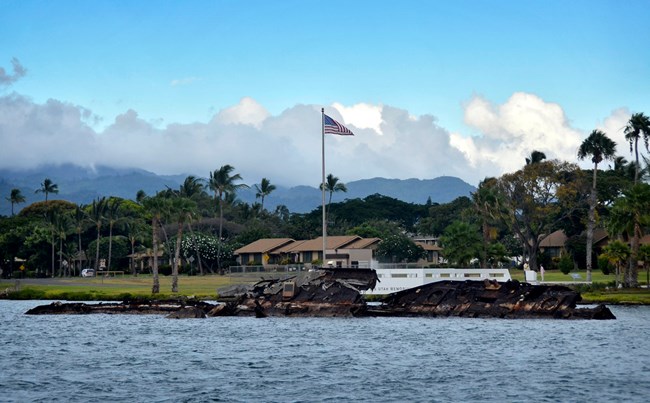Part of a series of articles titled 2023 Preservation Planning Grants Highlights.
Article
America’s Infamous Day: Interpreting a Key Portion of the Pearl Harbor Battlefield

Image courtesy of the National Park Service, Pearl Harbor National Memorial
Recipient: Pearl Harbor Aviation Museum
Amount: $140,043.85
On December 7, 1941, Ford Island, a low sandy landmass in the middle of Pearl Harbor, became the main target of Imperial Japanese bomber planes, as they carried out their surprise attack on the American naval fleet and army installations in Hawaii. Designed to cripple the United States’ ability to wage war in the Pacific, the aftermath of the attack had the exact opposite effect.
Despite the physical damage that the Japanese attack achieved, it failed in its primary task – to destroy American aircraft carriers and deliver a blow to US morale. Instead, Pearl Harbor quickly became a symbol for the United States to rally around. Recruitment posters and cries of “Remember Pearl Harbor” galvanized thousands of Americans to enlist and fight back against Imperial aggression in the Pacific. Within six months, the US Navy would counter the Japanese at the Battles of Coral Sea and Midway, and American marines and infantry would begin their long Island-hopping campaign towards the Japanese home Islands.
Today, many of Ford Islands’ historic buildings still stand. Repaired after the Japanese attack, the hangars and support structures along the Island’s runway now house the Pearl Harbor Aviation Museum, a non-profit institution tasked with retelling the history of the island and its role in America’s entry into the Second World War.
A 2023 Preservation Planning Grant from the American Battlefield Protection Program to the Pearl Harbor Aviation Museum will fund the development of an updated interpretation plan for the Ford Island battlefield and its historic resources, to include the broader history of the Island. The Museum will utilize new research and web-based mapping features to tell the story of Ford Island from its settlement by Native Hawaiian groups, to its use as a military installation during and after the attack on Pearl Harbor.
Preservation Planning Grants are the American Battlefield Protection Program's broadest and most inclusive grant program, promoting the stewardship of battlefields and sites of armed conflict on American soil. In addition, ABPP administers three other grant opportunities: the Battlefield Land Acquisition Grant, Battlefield Restoration Grant, and Battlefield Interpretation Grant programs. This financial assistance generates community-driven stewardship of historic resources at the state, tribal and local levels.
Get Your Project Funded
Check out the American Battlefield Protection Program's website for more information about various grant offerings and eligibility.
Last updated: July 26, 2023
